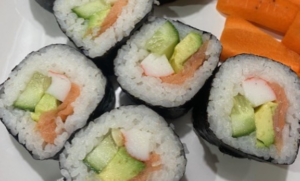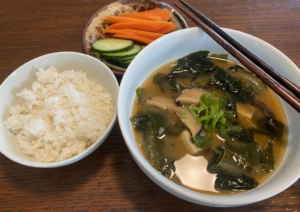Have you ever heard the word UMAMI?
“UMAMI” means “deliciousness” in Japanese.
SO, where the deliciousness is coming from in Japanese cuisine?
The answer is “fermented foods”!
Today I would like to share how you can make “fermented seasonings” in your own kitchen.
With these fermented seasonings, let’s start healthy living just like Japanese do.
Salt Koji
Ingredients
1 and 1/4 cups warm water
3tablespoons sea salt
7oz RICE KOJI
Procedure
- Prepare boiling water in a big pot. Heat a jar in simmering water for 10 minutes to sanitize.
- Add warm water and salt in the sanitized jar. Mix well until salt dissolves.
- Cool the salty water to 140F.
- Break the chunk of rice koji into smaller pieces and add to the salty water. Mix well.
- Put the lid on loosely.
- Leave at room temperature for 1 week. Mix daily.
(Most likely you will find the salt koji a bit dry 24 hours after making. If so, please add enough water to submerge the rice koji particles.)
- After 1 week, keep it in the refrigerator. It will last for 6 months.
How to use Salt koji
Salt koji can be used as a replacement for salt.
It will be great for stir frying, soup, and marinade.
Thanks to the fermentation process, salt koji has a lot of flavors compared with regular salt.

Soy sauce Koji
Ingredients
3/4cup Tamari soy sauce
3 oz Rice koji
Procedure
- Prepare boiling water in a big pot. Heat a jar in simmering water for 10 minutes to sanitize.
- Put Tamari soy sauce in the sanitized jar.
- Add rice koji to the jar. Mix well.
- Put the lid on loosely.
- Leave at room temperature for 1 week. Mix daily.
(Most likely you will find the soy sauce koji a bit dry 24 hours after making. If so, please add enough soy sauce to submerge the rice koji particles.)
- After 1 week, keep it in the refrigerator. It will last for 6 months.
How to use Soy sauce koji
Soy sauce koji can be used as a replacement for regular soy sauce.
It will work great for stir frying, soup, marinade, and dressing.
Thanks to the fermentation process, soy sauce koji has a lot of flavors compared with regular soy sauce.

I hope this information will help you enjoy the Japanese healthy living!
Thanks for reading!
Misaeng & Misen & Mimoza



